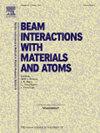新先进的射频四极杆在VERA的试验台进行了首次性能测试
IF 1.4
3区 物理与天体物理
Q3 INSTRUMENTS & INSTRUMENTATION
Nuclear Instruments & Methods in Physics Research Section B-beam Interactions With Materials and Atoms
Pub Date : 2025-05-14
DOI:10.1016/j.nimb.2025.165751
引用次数: 0
摘要
为科隆大学阴离子激光等压线分离器(ALIS)开发了一种新的先进射频四极(RFQ)离子冷却器,用于加速器质谱分析。基于维也纳环境研究加速器(VERA)的离子-激光相互作用质谱(ILIAMS)装置,它具有新的引导电极和离子光学,试图解决减速和捕获强重分子离子束(如SrF3−)的挑战。用27AlO -和63Cu -进行的初步测试显示,传输率为~ 30%,离子停留时间为毫秒,表明冷却器工作正常。虽然很有希望,但需要进一步的优化才能完全实现期望的效率和稳定性。本文章由计算机程序翻译,如有差异,请以英文原文为准。
First performance tests of the new advanced radiofrequency quadrupole for ALIS at the test bench setup at VERA
A new advanced radiofrequency quadrupole (RFQ) ion cooler for accelerator mass spectrometry has been developed for the Anion Laser Isobar Separator (ALIS) at CologneAMS. Based on the Ion-Laser Interaction Mass Spectrometry (ILIAMS) setup at the Vienna Environmental Research Accelerator (VERA), it features new guiding electrodes and ion optics trying to solve challenges in decelerating and trapping intense heavy molecular ion beams, such as SrF3−. Initial tests with 27AlO− and 63Cu− show ∼ 30% transmission and millisecond ion residence times, demonstrating that the cooler is functioning properly. While promising, further optimizations are needed to fully achieve the desired efficiency and stability.
求助全文
通过发布文献求助,成功后即可免费获取论文全文。
去求助
来源期刊
CiteScore
2.80
自引率
7.70%
发文量
231
审稿时长
1.9 months
期刊介绍:
Section B of Nuclear Instruments and Methods in Physics Research covers all aspects of the interaction of energetic beams with atoms, molecules and aggregate forms of matter. This includes ion beam analysis and ion beam modification of materials as well as basic data of importance for these studies. Topics of general interest include: atomic collisions in solids, particle channelling, all aspects of collision cascades, the modification of materials by energetic beams, ion implantation, irradiation - induced changes in materials, the physics and chemistry of beam interactions and the analysis of materials by all forms of energetic radiation. Modification by ion, laser and electron beams for the study of electronic materials, metals, ceramics, insulators, polymers and other important and new materials systems are included. Related studies, such as the application of ion beam analysis to biological, archaeological and geological samples as well as applications to solve problems in planetary science are also welcome. Energetic beams of interest include atomic and molecular ions, neutrons, positrons and muons, plasmas directed at surfaces, electron and photon beams, including laser treated surfaces and studies of solids by photon radiation from rotating anodes, synchrotrons, etc. In addition, the interaction between various forms of radiation and radiation-induced deposition processes are relevant.

 求助内容:
求助内容: 应助结果提醒方式:
应助结果提醒方式:


